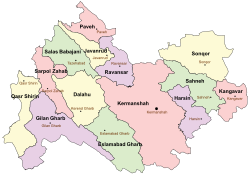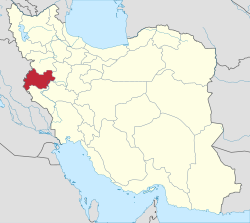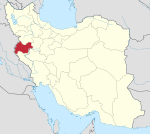Sonqor County
Sonqor County
Persian: شهرستان سنقر | |
|---|---|
 Location of Sonqor County in Kermanshah province (right, yellow) | |
 Location of Kermanshah province in Iran | |
| Coordinates: 34°52′N 47°30′E / 34.867°N 47.500°E[1] | |
| Country | Iran |
| Province | Kermanshah |
| Capital | Sonqor |
| Districts | Central, Bavaleh, Kolyai |
| Population (2016)[2] | |
• Total | 81,661 |
| Time zone | UTC+3:30 (IRST) |
| Website | Website of CHHTO of Kermanshah |
| Sonqor County can be found at GEOnet Names Server, at this link, by opening the Advanced Search box, entering "9206875" in the "Unique Feature Id" form, and clicking on "Search Database". | |
Sonqor County (Persian: شهرستان سنقر) is in Kermanshah province, Iran. Its capital is the city of Sonqor.[3]
History
[edit]In 2021, Bavaleh and Gavrud Rural Districts were separated from the Central District in the formation of Bavaleh District.[4]
Demographics
[edit]Language and ethnicity
[edit]The majority of the people in this county are Kurds and Turkics.[5] Sonqor county is made up of two distinct population elements.[5] The city of Sonqor and the villages of Qalʿa-ye Farhād Khan and Qorva are predominantly populated by Turkics, whose ancestors reportedly arrived during the Mongol domination of Iran.[5][6] The Turkic people of Sonqor originally speak the Sonqori dialect.[6] The dialects of Sonqori spoken in Qalʿa-ye Farhād Khan and Qorva differ barely from this main dialect.[6]
The other areas within Sonqor County are predominantly populated by Kurds most of whom have originally been agriculturalists.[5] The chiefs of the Kurds of Sonqor County belonged to the Kulya'i tribe.[5] These Kurdish feudal lords (khans) were in control of the Kurdish-populated parts of the county until early 20th century Qajar Iran, and were reportedly scions (in the eighth generation) of a certain Safi Khan who lived in the later Safavid period.[5] In 1786, the district was ceded to Ardalan as a gift from Agha Mohammad Khan Qajar.[7] In 1798, Ali Hemmat Khan and his brother Baba Khan of the Nanakali tribe were executed by Iranian ruler Fath-Ali Shah Qajar (r. 1797-1834) as they had supported Soleyman Khan, the pretender to the Iranian throne.[5] The Kulya'i Kurds of the Sonqor District speak a Kurdish dialect that resembles the dialect of Kermanshah, and, according to the second edition of the Encyclopaedia of Islam are thought to be affiliated to the Ahl-e Haqq syncretic religion.[5] At least 177 villages in the county speak the Kulya'i dialect, 112 of these are in the Kolyai District.[8]
Population
[edit]At the time of the 2006 National Census, the county's population was 95,904 in 23,755 households.[9] The following census in 2011 counted 91,935 people in 26,201 households.[10] The 2016 census measured the population of the county as 81,661 in 25,554 households.[2]
Administrative divisions
[edit]Sonqor County's population history and administrative structure over three consecutive censuses are shown in the following table.
| Administrative Divisions | 2006[9] | 2011[10] | 2016[2] |
|---|---|---|---|
| Central District | 80,304 | 78,282 | 70,284 |
| Ab Barik RD | 6,419 | 5,605 | 4,328 |
| Bavaleh RD | 9,364 | 9,069 | 7,114 |
| Gavrud RD | 9,512 | 7,719 | 5,770 |
| Parsinah RD | 5,899 | 5,478 | 4,364 |
| Sarab RD | 5,926 | 5,457 | 4,452 |
| Sonqor (city) | 43,184 | 44,954 | 44,256 |
| Bavaleh District[a] | |||
| Bavaleh RD | |||
| Gavrud RD | |||
| Kolyai District | 15,600 | 13,653 | 11,363 |
| Agahan RD | 5,061 | 4,189 | 3,424 |
| Kivananat RD | 4,095 | 4,056 | 3,130 |
| Satar RD | 5,160 | 4,181 | 3,761 |
| Satar (city) | 1,284 | 1,227 | 1,048 |
| Total | 95,904 | 91,935 | 81,661 |
| RD = Rural District | |||
See also
[edit]![]() Media related to Sonqor County at Wikimedia Commons
Media related to Sonqor County at Wikimedia Commons
Notes
[edit]References
[edit]- ^ OpenStreetMap contributors (13 December 2024). "Sonqor County" (Map). OpenStreetMap (in Persian). Retrieved 13 December 2024.
- ^ a b c Census of the Islamic Republic of Iran, 1395 (2016): Kermanshah Province. amar.org.ir (Report) (in Persian). The Statistical Center of Iran. Archived from the original (Excel) on 3 April 2022. Retrieved 19 December 2022.
- ^ Habibi, Hassan (19 November 2013) [Approved 21 June 1369]. Approval of the organization and chain of citizenship of the elements and units of the national divisions of Bakhtran province, centered in the city of Bakhtran. rc.majlis.ir (Report) (in Persian). Ministry of the Interior, Defense Political Commission of the Government Board. Proposal 3233.1.5.53; Letter 93808/907; Notification 82832/T122K. Archived from the original on 6 February 2013. Retrieved 29 January 2024 – via Research Center of the System of Laws of the Islamic Council of Farabi Mobile Library.
- ^ a b Jahangiri, Ishaq (c. 2023) [Approved 27 April 1400]. Changes in national divisions in Sonqor County, Kermanshah province. qavanin.ir (Report) (in Persian). Ministry of the Interior, Council of Ministers. Archived from the original on 19 July 2023. Retrieved 19 July 2023 – via Laws and Regulations Portal of the Islamic Republic of Iran.
- ^ a b c d e f g h Minorsky 1997.
- ^ a b c Knüppel 2010.
- ^ Fisher, William Bayne; Avery, P.; Hambly, G. R. G.; Gershevitch, Ilya; Melville, C.; Boyle, John Andrew; Frye, Richard Nelson; Yarshater, Ehsan; Jackson, Peter (1968). The Cambridge History of Iran. Cambridge University Press. ISBN 978-0-521-20095-0.
- ^ Fattah (2000), p. 19.
- ^ a b Census of the Islamic Republic of Iran, 1385 (2006): Kermanshah Province. amar.org.ir (Report) (in Persian). The Statistical Center of Iran. Archived from the original (Excel) on 20 September 2011. Retrieved 25 September 2022.
- ^ a b Census of the Islamic Republic of Iran, 1390 (2011): Kermanshah Province. irandataportal.syr.edu (Report) (in Persian). The Statistical Center of Iran. Archived from the original (Excel) on 18 January 2023. Retrieved 19 December 2022 – via Iran Data Portal, Syracuse University.
Sources
[edit]- Fattah, Ismaïl Kamandâr (2000), Les dialectes kurdes méridionaux, Acta Iranica 37
- Knüppel, Michael (2010) [2000]. "TURKIC LANGUAGES OF PERSIA: AN OVERVIEW". Encyclopædia Iranica.
- Minorsky, V. (1997). "Sunḳur". In Bosworth, C. E.; van Donzel, E.; Heinrichs, W. P. & Lecomte, G. (eds.). The Encyclopaedia of Islam, Second Edition. Volume IX: San–Sze. Leiden: E. J. Brill. ISBN 978-90-04-10422-8.

